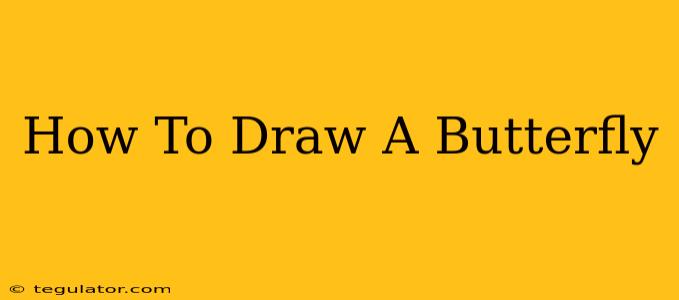Butterflies, with their vibrant wings and graceful flight, are a favorite subject for artists of all levels. This guide will walk you through drawing a butterfly, from simple shapes to intricate details, catering to both beginners and those looking to refine their skills. Whether you're aiming for a realistic portrayal or a whimsical interpretation, these steps will help you capture the beauty of these enchanting insects.
Getting Started: Essential Materials
Before you begin your artistic journey, gather your essential materials:
- Paper: Use smooth drawing paper or sketch paper for optimal results. Heavier weight paper is recommended to prevent smudging and tearing.
- Pencils: A range of pencils (e.g., HB, 2B, 4B) will allow you to vary line weight and shading. A lighter pencil (HB) is ideal for sketching, while darker pencils (2B, 4B) are perfect for adding detail and depth.
- Eraser: A kneaded eraser is highly recommended as it’s versatile and allows for precise erasing without damaging the paper.
- Colored Pencils, Markers, or Paints (Optional): To bring your butterfly to life with color!
Step-by-Step Butterfly Drawing Tutorial
Let's begin creating your butterfly masterpiece!
Step 1: Sketching the Body
- Start with a simple oval: Draw a slightly elongated oval for the butterfly's body. This will form the thorax and abdomen.
- Add the head: Draw a small circle at one end of the oval for the head.
- Antennae: Extend two thin, slightly curved lines from the head to create the antennae. Experiment with the shape of the antennae – they can be straight, curved, or even beaded.
Step 2: Outlining the Wings
- Two pairs of wings: On either side of the body, sketch two pairs of wings. Begin with simple shapes, such as ovals or teardrops for the upper wings and smaller, more rounded shapes for the lower wings. Don't worry about making them perfectly symmetrical at this stage.
- Varying wing shapes: Butterflies exhibit a huge variety of wing shapes. Experiment! You can make the wings elongated, rounded, pointed, or even jagged.
Step 3: Adding Wing Details
- Veins: Lightly sketch in the wing veins. These are the lines that run through the wings, creating a delicate framework. You can create a simple branching pattern or more intricate designs depending on your desired level of realism.
- Patterns and markings: This is where your creativity truly shines! Add spots, stripes, swirls, or other patterns to the wings. Observe real butterfly wings for inspiration or create your own unique designs. Use a variety of pencil strokes to give texture and depth to your patterns.
Step 4: Refining and Shading
- Refining the outlines: Once you are happy with the basic shape and patterns, refine the outlines of the wings and body. Use darker pencils to create bolder lines.
- Shading: Use shading to give your butterfly three-dimensionality. Observe how light falls on a real butterfly's wings and body to guide your shading. Use lighter shading for highlights and darker shading for shadows. Blending techniques can help create a smooth, realistic effect.
Step 5: Adding Color (Optional)
- Choosing your colors: Select your colored pencils, markers, or paints. Consider the colors of real butterflies or let your imagination guide you.
- Applying color: Gently apply color to the wings and body, layering colors to create depth and richness. Leave some areas uncolored for highlights.
Tips for Success
- Practice makes perfect: Don't be discouraged if your first attempt isn't perfect. Keep practicing, and you'll gradually improve your skills.
- Observe real butterflies: Study photographs or real butterflies to understand their wing shapes, patterns, and details.
- Experiment with different styles: Try drawing butterflies in different poses and styles, from realistic to cartoonish.
- Have fun! Drawing should be an enjoyable experience. Relax, let your creativity flow, and enjoy the process of creating your butterfly masterpiece.
By following these steps and incorporating your own creative flair, you'll be well on your way to drawing stunning butterflies! Remember to share your creations – we’d love to see them!

